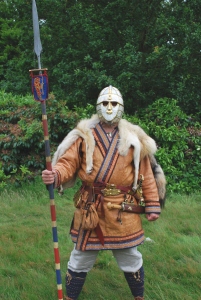 ‘Brightfire’ (and its ‘prequel’ – ‘Storm Frost’) is set in the first quarter of the 7th century – up to the 630’s AD. This is the period in which Pope Gregory sent Augustine with his companions on a mission to convert the English to the Roman Christian church.
‘Brightfire’ (and its ‘prequel’ – ‘Storm Frost’) is set in the first quarter of the 7th century – up to the 630’s AD. This is the period in which Pope Gregory sent Augustine with his companions on a mission to convert the English to the Roman Christian church.
We are on the cusp of religious change. Some parts of Britain had already accepted Christianity from the west (the Irish church) and the south (the Frankish) but East Anglia had remained pagan.
The Anglo-Saxons, like their Nordic forebears, worshipped Woden (=Odin), Thor, Tiw, Freya, Frig etc, etc ; we use their names most days of the week! These gods, and others, represent aspects like knowledge, creativity, power, strength, valour, fertility, abundance etc, all of which we, of course, still value and respect today.
Our ancestors, like the Klingons in ‘Star Trek’, believed in Honour, Death or Glory, the punishment of the dishonourable, and they despised cowardice. And, like the Klingons, they were spiritual, worshipping and honouring the gods just mentioned: a whole pantheon of them. Like Klingons, they enjoyed conviviality, feasting, drinking and singing – and telling stories of their heroes.
This is the cultural background for what happens in ‘Brightfire’. We learn from the Venerable Bede that Raedwald of Sutton Hoo was called to Canterbury by his High King (Aethelbert of Kent) and was baptised. He returned to his kingdom of East Anglia and built a church close to his royal hall at Rendlesham in Suffolk – with two altars: one to Christ and one to Woden.
His queen and counsellors resisted the new Christian religion, but maybe Raedwald was adopting a policy of ‘live and let live’ – he does not do what happens in some other areas of Britain, where atrocities were committed against Christians. So – anything for a quiet life at home as well as in the community?
I suggest this interpretation in ‘Brightfire’, where the king takes this attitude, though his queen is antagonistic. I use the two priests: Garmund, “the priest of Woden, bony skull covered with a wolf-head, blind in one eye, like his god”, ready to read and to cast runes for guidance; the other is Paulinus, one of Augustine’s companions, carrying his holy book and a cross: he was “tall and dark, olive-skinned and with a nose as hooked as an eagle’s”. These represent the two religions, which will develop into a vital point of conflict as the tale develops.
Bede tells us that Raedwald’s second son becomes king after his father’s death, and that he is a pagan, until the whole kingdom is forced to become Christian, once Raedwald’s ally, Edwin becomes High King in his turn, is converted, and insists that all the regions of his realm follow suit.
The old gods seem to fade into the mists – except in the hearts of a few, like Niartha (my leading lady) and her son Ricberht, both in increasing danger from Eorpwald, who uses religion as an excuse for his actions.
Will humans ever learn?